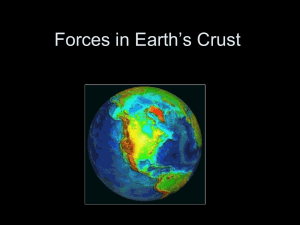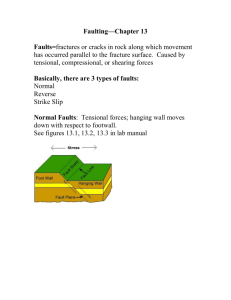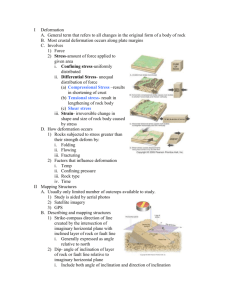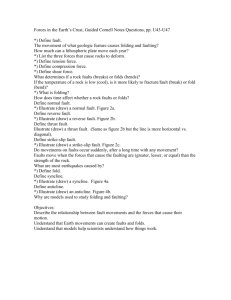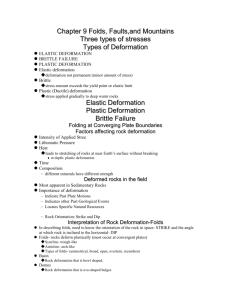Chapter 17
advertisement
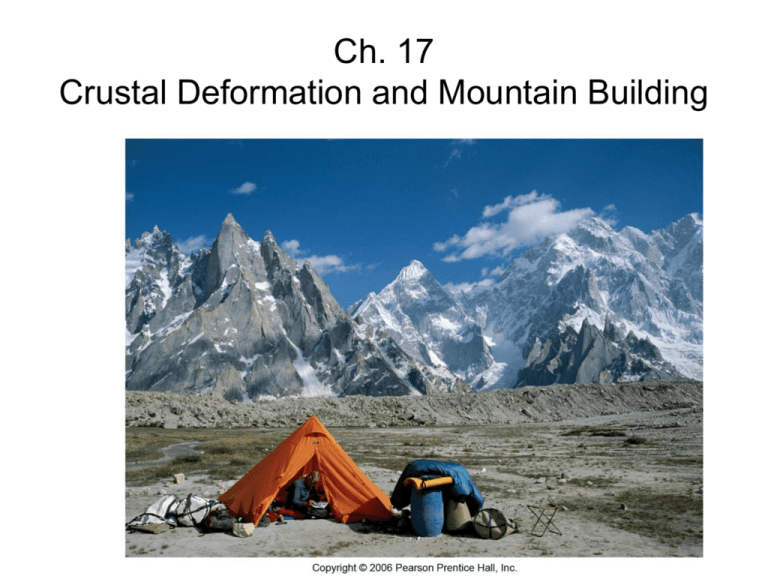
Ch. 17 Crustal Deformation and Mountain Building Chapter 17 Opening Figure Rock Deformation Rock deformation refers to changes in the shape, volume, or orientation of a rock due to changes in temperature and pressure over time. Rock Deformation due to Stress Stress is strictly defined as force per unit area, and is used to describe all forces that deform rocks • Compressional stress (squeezes and shortens) • Tensional stress (elongates) • Shear stress (causes splaying, e.g. deck of cards). Elastic deformation • We’ve already talked about elastic deformation, which is temporary. The rock will return to original shape and form after stress is removed. • What happens if the elastic limit is surpassed? Brittle Deformation: Rocks behave like a brittle solid and fracture • near surface conditions • relatively low pressures and temperatures • result is faulting Ductile deformation: solid state flow of rocks that results in permanent deformation without fracture • conditions at depth • relatively high pressures and temperatures • result is folding Factors in Rock Deformation • • • • Pressure Temperature Rock composition Time rock is exposed to pressure and temperature Synclines and Anticlines • An anticline is a structure in which the strata (layers) in the middle are older than those of the limbs (sides). • Anticlines are formed by upfolding or arching of rock layers. • A syncline (“sin makes you smile”) is a structure in which the strata in the middle are younger than those of the limbs. • Synclines are formed by downfolding of rock layers. Synclines and Anticlines • These two types of folds are most often found in adjacent to one another. • Both are examples of ductile deformation. • Both are commonly due to horizontal compressional stress. Anticline Syncline: See the smile? Syncline, anticline, syncline (the right syncline is cut by a vertical fault) Overturned Fold Plunging Folds Synclines and anticlines are “plunging” when their axis is no longer parallel to the land surface, due to a perpendicular component of stress. Plunging folds vs non-plunging folds Monocline • A monocline is a large, steplike fold in otherwise horizontal sedimentary strata • Monoclines are associated with the reactivation of faults of faults in the basement rock below the sediments. The San Rafael Swell in Utah, is an example of a monocline Brittle Deformation: Faults Faults- fractures in rocks along which there is (or has been) displacement. Dip-Slip Faults • Movement primarily along the inclination (dip) of fault plane (i.e. up/down) • Parts of a dip-slip fault – Hanging wall – the rock above the fault surface – Footwall – the rock below the fault surface Normal Dip-Slip Fault • Hanging wall block moves down due to gravity (that’s the normal part • Associated with fault-block mountains • Prevalent at spreading centers • Caused by tensional forces. Fault block mountain range produced by normal faulting Horst (high)– uplifted block, Graben (grave) – downdropped block • Horst and Graben Topography: results from a series of normal faults in an extensional environment. • Dip of normal faults decrease with depth. • Nearly horizontal detachment fault separates brittle deformation above with ductile deformation below. Basin and Range Geographic Province, (Nevada and parts of California, Utah) Reverse Dip-slip Faults and Thrust Fault • Hanging wall block moves up (this is the reverse of normal!) • Caused by strong compressional stresses • Reverse fault - dips greater than 45º • Thrust fault - dips less than 45º Thrust fault – low angle reverse fault Thrust Fault in Nevada What kind of fault, normal or reverse? Strike-Slip Faults: Dominant displacement is horizontal and parallel to the trend, or strike Strike-slip vs. Transform • Strike-slip faults – Dominant displacement is horizontal and parallel to the trend, or strike – Often associated with tranform-fault boundaries, BUT – Not all strike-slip faults are transform! Strike-slip vs. Transform • Transform fault – Strike-slip fault that links spreading centers lithosphere – Considered a plate boundary if large enough – All transform faults are strike-slip, as they move parallel to strike. Strike-slip faults are classified as right-lateral or left lateral. Which is the San Andreas? Right-lateral or Left lateral? San Andreas Fault System San Andreas Fault System From E to W, San Andreas, San Jacinto, Elsinore Faults Peninsular Ranges Batholith and Transverse Ranges Extension in the Basin and Range Figure 17.20 Joints • • Fractures along which no appreciable displacement has occurred Most are formed when rocks in the outer-most crust are deformed Figure 17.11 Orogenesis (Mountain Building) Orogenesis Processes that collectively produce a mountain belt Occurs due to plate movements and often (not always!) at plate boundaries. Orogenesis at Convergent Boundaries Island Arcs (Oceanic-oceanic crust convergence ) • Subduction zone forms • Volcanic arc forms • Often associated with deep ocean trench Volcanic Island Arc Orogenesis at Convergent Boundaries Andean-type orogenesis (Oceaniccontinental crust convergence ) • Subduction zone forms • Continental volcanic arc forms • Accretionary wedge* forms seaward of arc *Large mass of sediments scraped from subducting oceanic plate which attaches to to the overiding block Andean-Type Orogenesis Andean-Type Orogenesis Andean-Type Orogenesis Andean-type orogenesis Active Examples-Volcanic Arcs Andes (accretionary wedge under water?) Cascades – active volcanoes, slightly inland from non-volcanic coastal mountains, the Olympus Range. Inactive Example: Sierra Nevada Range (magma chamber of volcanic arc) and California's Coast Ranges (accretionary wedge) Orogenesis at convergent boundaries Accretion of Exotic Terranes • Small crustal fragments collide with and accrete to continental margins • Accreted crustal blocks are called terranes (note spelling). Terrane refers to any landmass that has a geologic history distinct from that of an adjoining landmass • Much of western North America is composed of exotic terranes. Accretion of Exotic Terranes Accretion of Exotic Terranes Accretion of Exotic Terranes Accreted Terranes in the Western United States Source material include: • island arc material (igneous parent rock) • submarine deposits (sedimentary parent rock) • Ancient ocean floor (igneous parent rock) • displaced continental (igneous parent rock) • Orogenesis at Convergent Boundaries Collisional Mountain Belt: Two plates with continental crust converge • Characterized by shortening and thickening of continental crust Formation of Himalayas Formation of Himalayas Collisional Mountain Ranges Active Example • Himalayan Mountains and the Tibetan Plateau Inactive Example Appalachians (collision of N. America and Africa) Figure 17.19a,b Figure 17.19b,c Figure 17.19c,d Landsat Image of Valley and Ridge Province, with location map on right. Orogenesis not associated with Convergence – Fault Block Mountains • Associated with Normal Faulting • Basin and Range Province • Teton Range, Wyoming Isostasy The earth’s lithosphere can be thought of as “floating” in gravitational balance upon the denser, deformable rocks in the asthenosphere. To support more weight (i.e mountains) above, means you need to displace more material below. Isostasy Horizontal compressional forces cause shortening and thickening of crust, in both directions. Isostatic Adjustment • As weight is removed from the top by erosion, the crust “rebounds” upward. • The processes of erosion and isostatic uplifting will continue until mountain block reaches normal thickness. • Eroded sediments cause adjacent areas to subside. Normal Fault FAULT SCARP Reverse Fault

